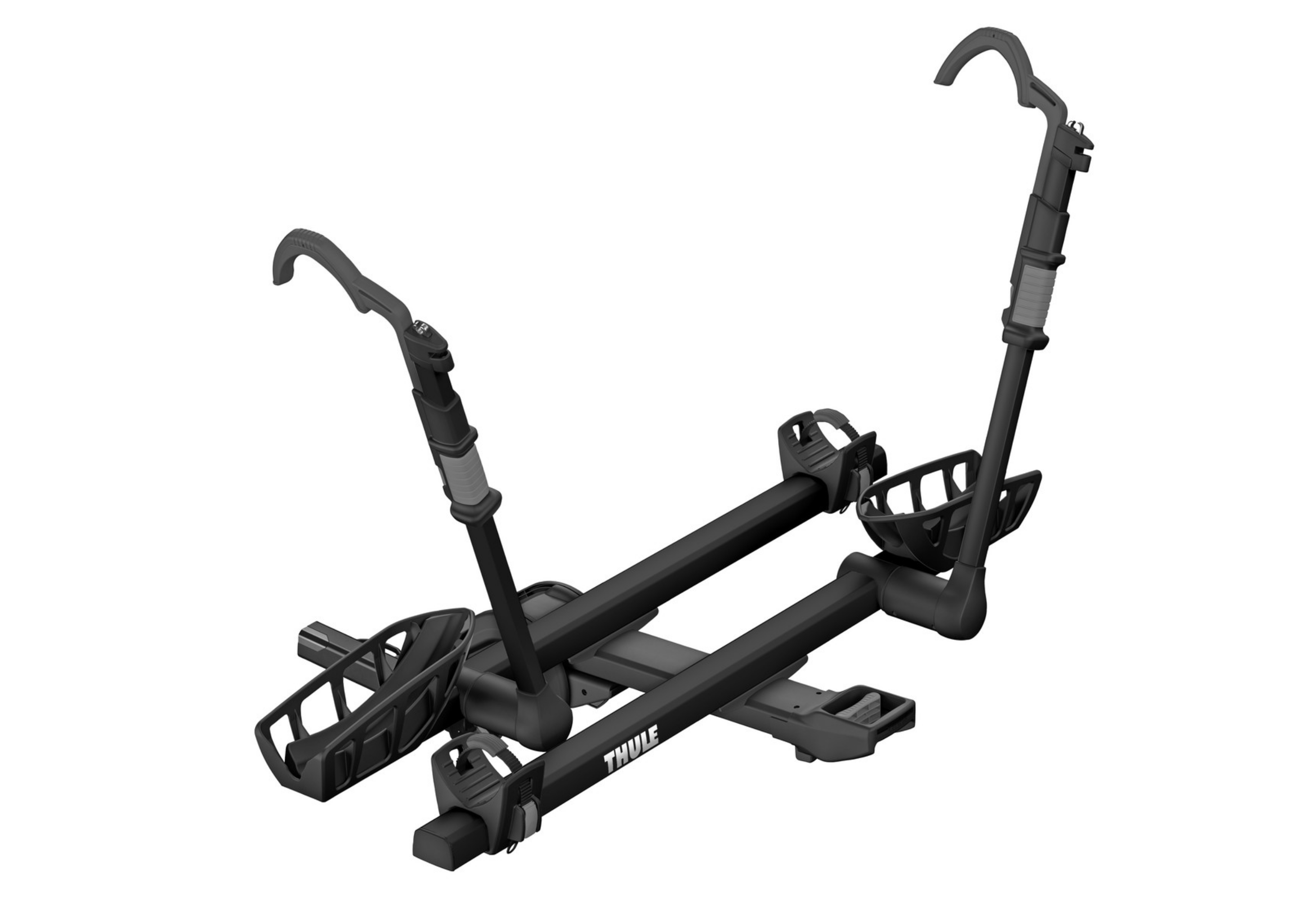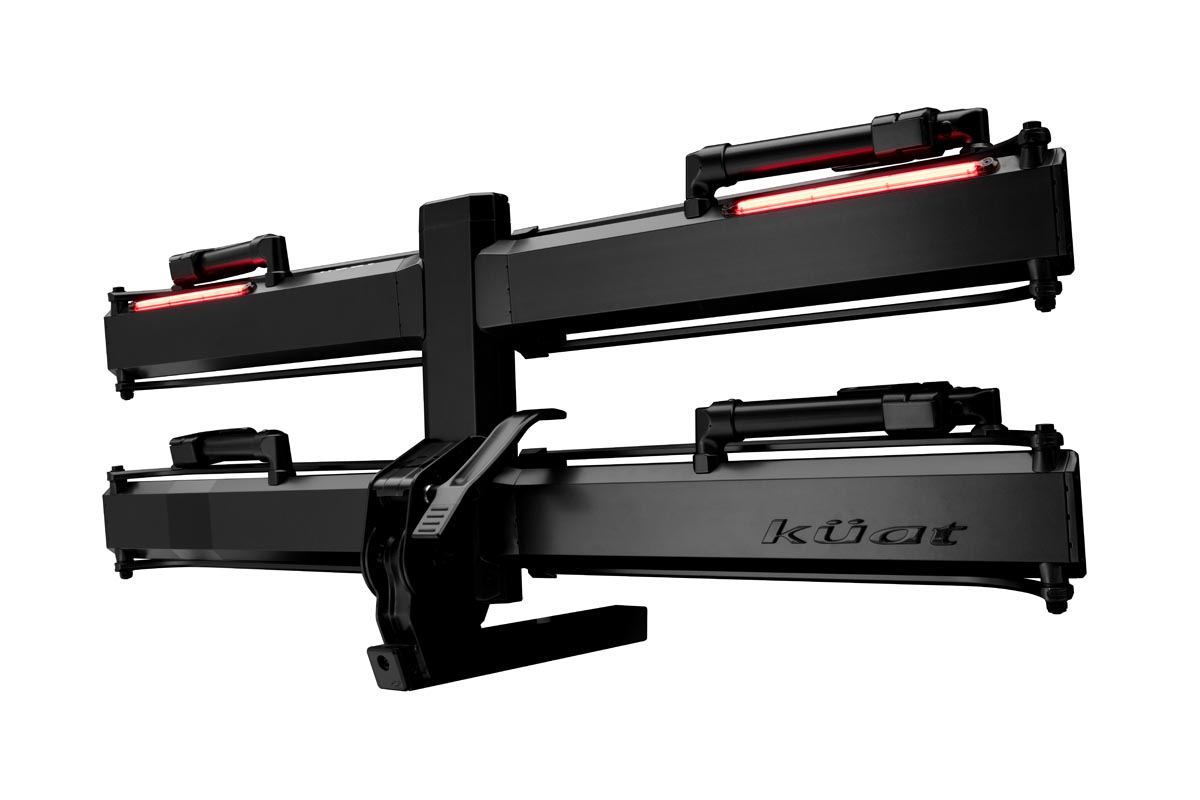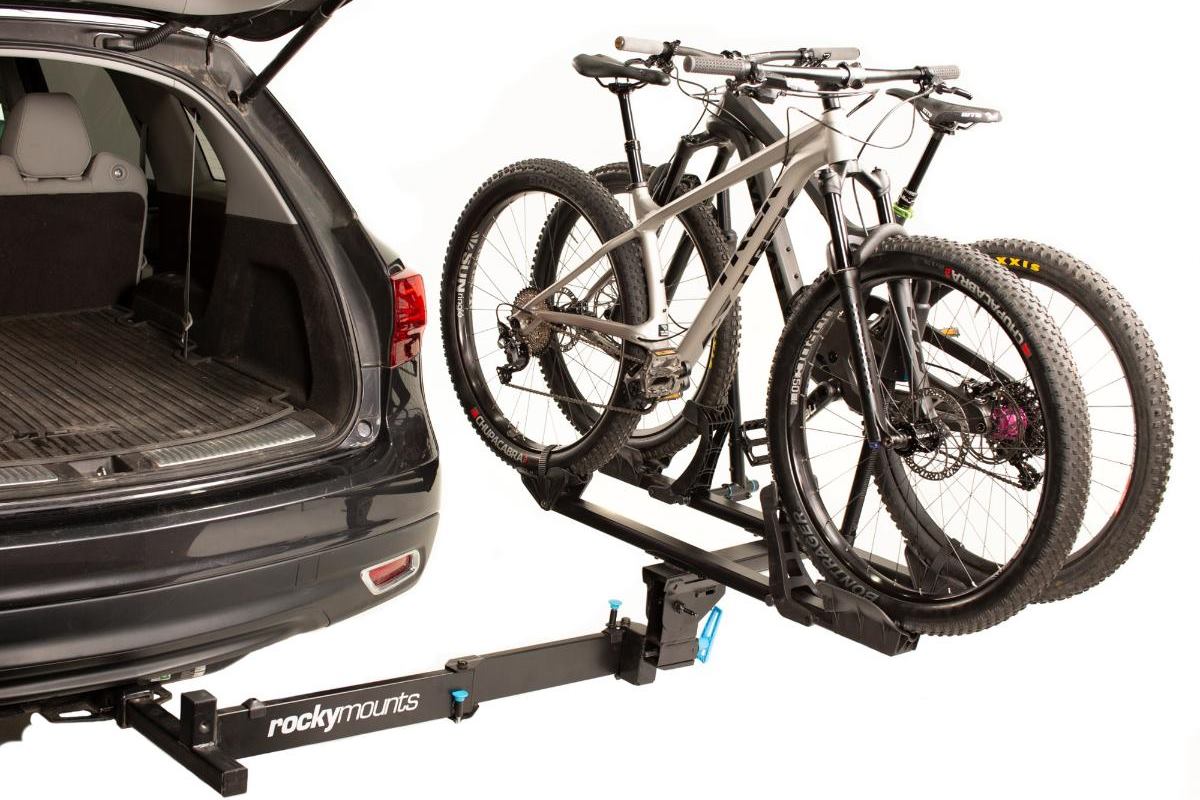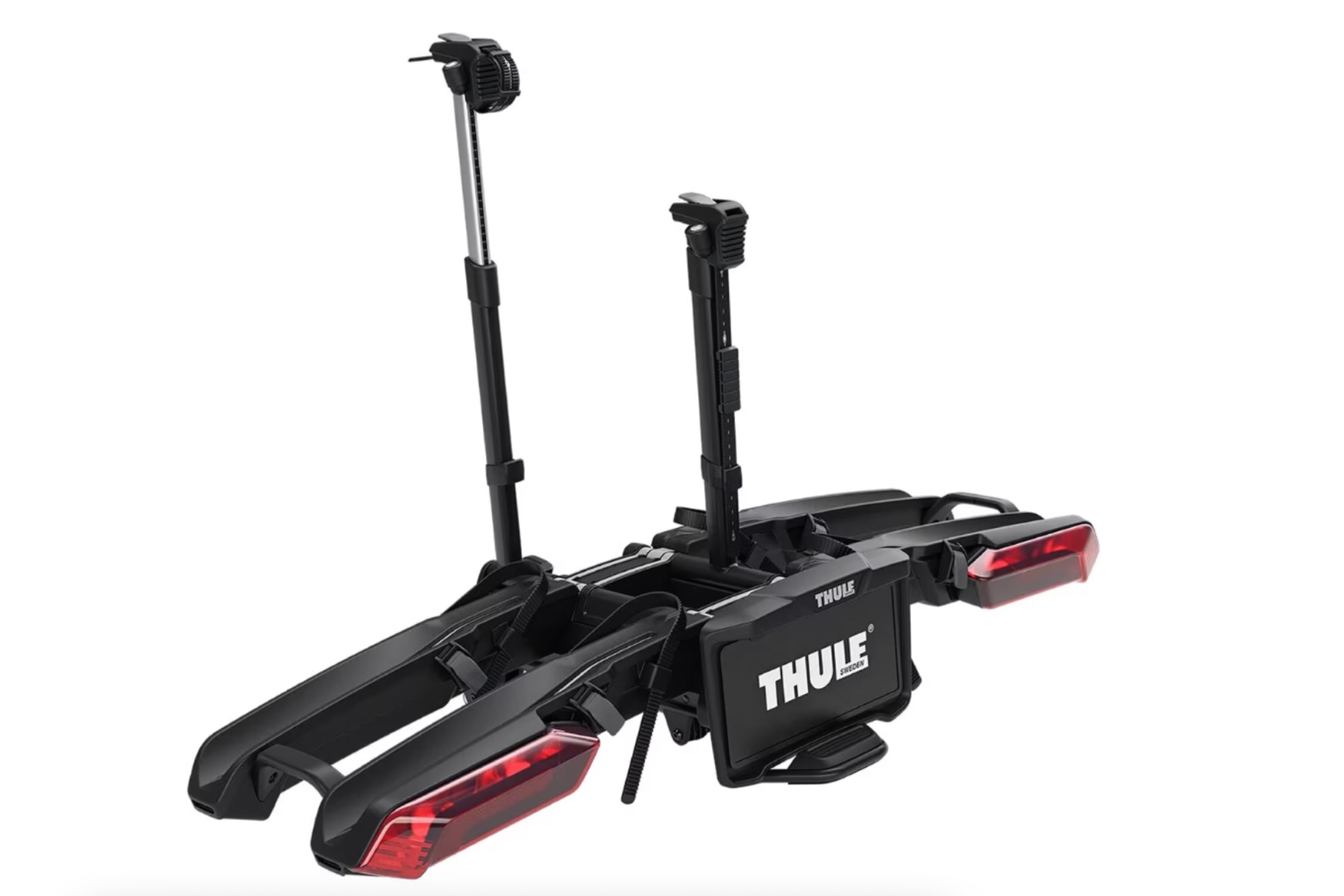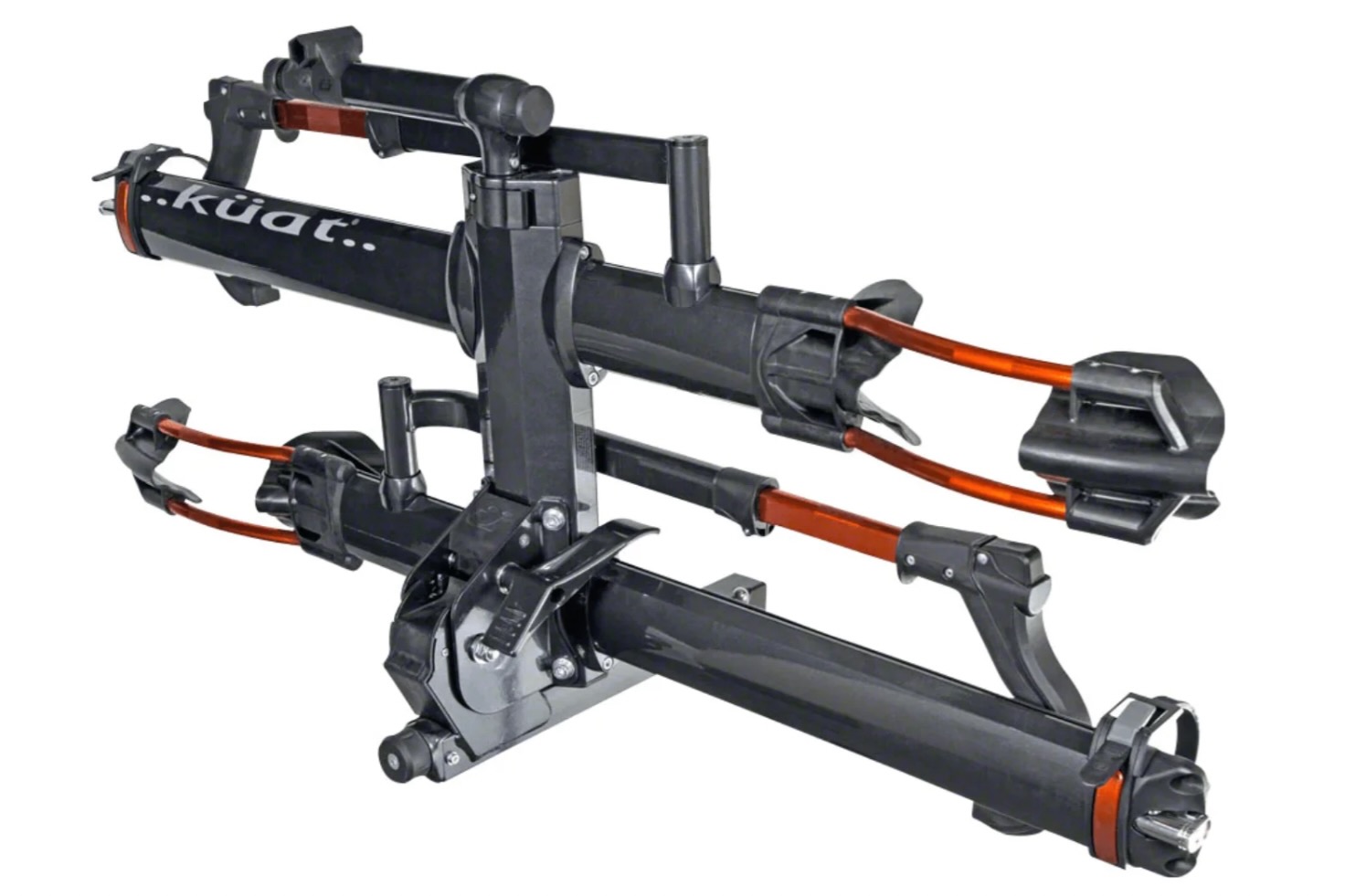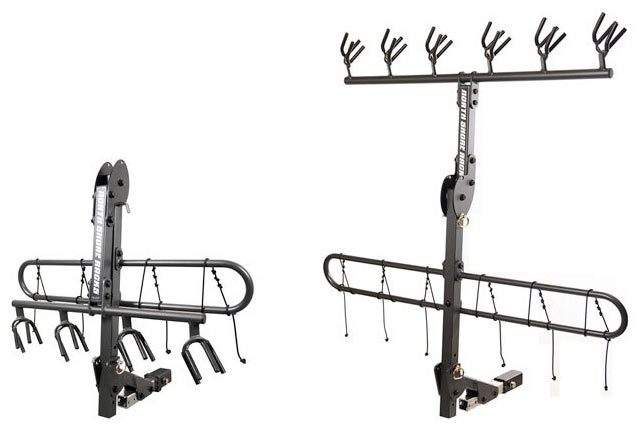There are various ways to transport bikes with your vehicle, but hitch bike racks are arguably the best. With so many models and styles to choose from, however, finding the perfect hitch rack for your needs and budget can be a challenge. At Bikerumor, we’ve tested dozens of the best hitch racks on the market to find the best ways to conveniently and safely transport your precious bikes wherever you go.
Whether you’re doing mountain bike shuttles with a big crew, heading out on a casual ride or to a race, or loading up the family for a weekend vacation, we’ve found the best options available in 2024. Our team assessed each model’s ease of use, weight limits, versatility, security features, and assembly, to provide you with the details you need to make a more informed purchase decision.
Here you’ll find our top recommendations followed by the best of the rest which are all also great products worthy of consideration. If you’d like to compare product specs be sure to check out our comparison chart and refer to our comprehensive buyer’s guide and FAQ to help answer any questions.
Editor’s Note: This review was updated on March 21, 2024, to reflect a number of price changes and ensure that our product selection and all of the information provided are as up-to-date as possible.
The Best Hitch Bike Racks of 2024
- Best Overall Hitch Bike Rack: Thule T2 Pro XTR
- Best Budget Hitch Bike Rack: Rocky Mounts MonoRail
- Best Premium Hitch Bike Rack: Kuat Piston Pro X
- Best Hitch Bike Rack for Durability: 1Up USA 2″ Heavy Duty Double
- Best Swing-Away Hitch Bike Rack: Rocky Mounts BackStage Swing Away
- Best Hitch Bike Rack for Storability and e-Bikes: Thule Epos
- Best Vertical Hanging Hitch Bike Rack: 1Up Recon 5
- Best Value Vertical Carry Hitch Bike Rack: VelociRAX
- Best Top Tube Hanging Hitch Bike Rack: Yakima FullSwing
Pros
- Easy to install and remove
- Easy to load bike
- User friendly tilt release
- Included locks for rack and bikes
- Transport wheels to roll rack
Cons
- Moderately expensive
- Bulky – takes up a lot of storage space

Rocky Mounts MonoRail
Pros
- Reasonable price
- Versatile bike fit
- 60 lbs weight limit
- Easy to use
Cons
- Included lock pods are plastic
- Sits close to vehicle, hitch extension may be needed with certain vehicles
- May not work with all muffler designs

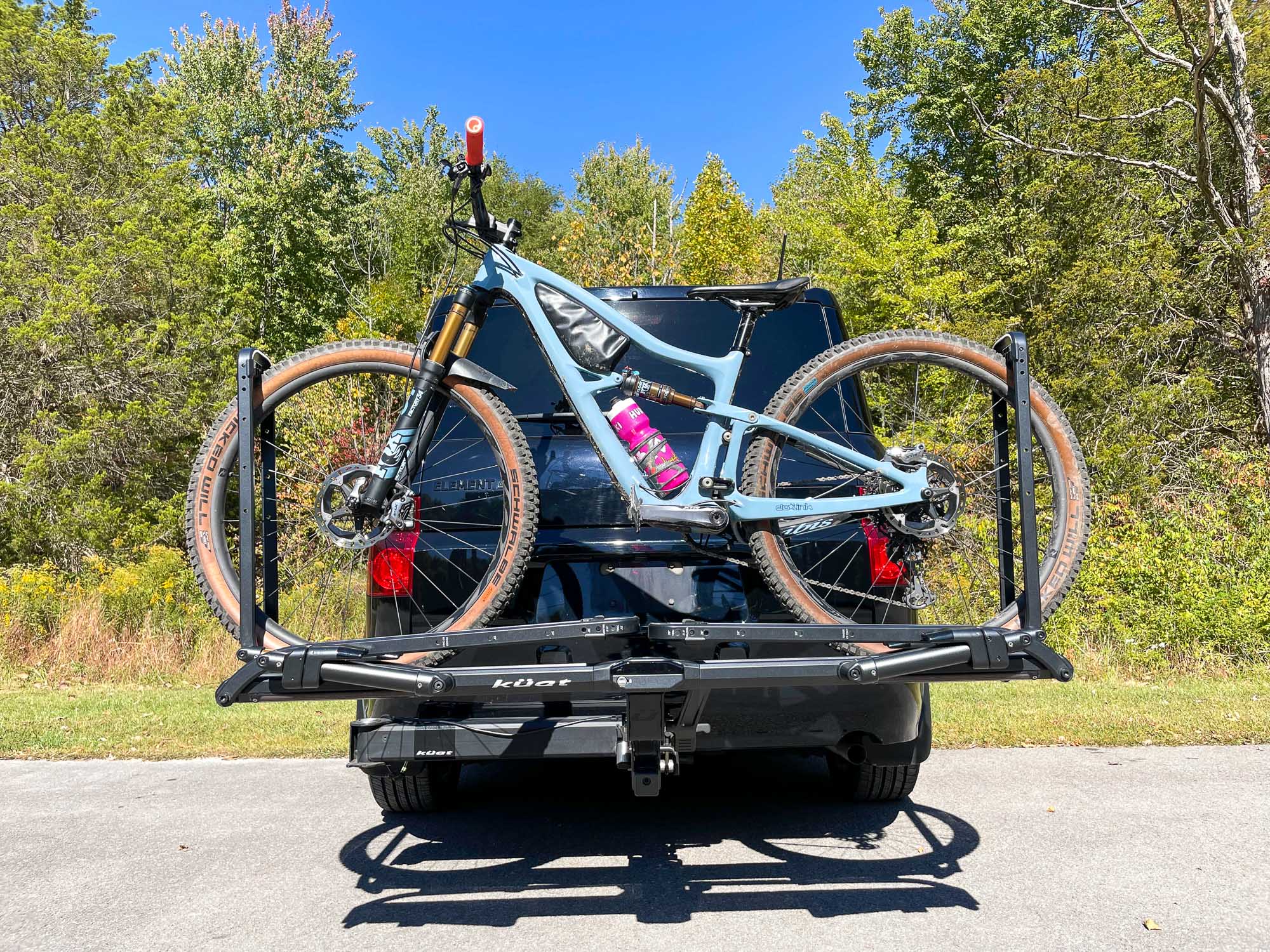
1Up USA 2″ Heavy Duty Double
Pros
- Super durable all metal construction
- Trays fold when not in use for easier storage
- Moderate rack weight
- Versatile bike fit
- No frame or rim contact
- Rated for RV, travel trailer, and off-road use
Cons
- Wheel size adjustments require tools
- Loading bikes can be slightly less user friendly than some similar racks
- Tilt release can be hard to reach

Rocky Mounts BackStage Swing Away
Pros
- Pivots 180 degrees to allow access to back of vehicle
- Lighter weight and more affordable than other racks plus swing away extension
- User friendly
- Versatile bike fit
Cons
- Only available in a 2” receiver size
- Sits close enough to the vehicle that a hitch extension may be required for handlebar clearance on some vehicles
- Not compatible with add-ons

Thule Epos
Pros
- 75 pound bike weight limit (up to 140 lbs total)
- Folds in half, very small footprint and size for storage
- Wheels and handles make it very easy to move around when not in use
- Works with virtually any bike
- Optional lights and license plate kit, loading ramp, high grade lock, and storage cover
- Comes in 2 and 3 bike versions
Cons
- Expensive
- Bike attachment is somewhat fiddly
- Lots of plastic parts

1Up USA Recon Rack
Pros
- All metal construction
- More versatile and easier to load than fork hang racks
- Choose preferred wheel baskets at checkout
- Tilts down for vehicle access
- No frame or fork contact
- Rated for off-road use
- Lifetime warranty
- Shipping included in purchase price
Cons
- Very Expensive
- Rear wheel strap design is super secure but a little fiddlier than other systems
- 45 lbs per bike weight limit doesn’t work with most full-power e-bikes
- Need to keep track of rear wheel straps

VelociRAX
Pros
- No frame contact
- Easy to load and unload bikes
- Hydraulic damper assist to lower rack, even with bikes loaded
- Comes in multiple versions to suit your carrying needs
- Comes with wall mount to support rack when not in use (can be used to store bikes on wall mount)
Cons
- Expensive
- Very large and heavy

Yakima FullSwing
Pros
- Swing-away feature
- Carries up to 4 bikes
- Padded bike cradles
- Zip strips are user-friendly
- Tool-free installation and removal
Cons
- Holds bike by the frame
- Bike on bike contact is difficult to avoid
- Design is inherently less stable than other styles of hitch racks
- 40 lbs per bike weight limit

Best of the Rest
Kuat Transfer V2 2-bike
Pros
- Light weight
- Reasonable price
- Versatile bike fit
- 60 lbs per bike weight limit
- Included security features
Cons
- Tilt-release lever can be awkward to operate with bikes loaded
- Less refined than more expensive competition
- More involved assembly
- No lateral bike adjustability
Yakima StageTwo
Pros
- Tough, overbuilt feel
- 70 pound weight limit
- Versatile bike fit
- Optional loading ramp for heavy bikes
- User-friendly features like remote tilt-release handle and SpeedKnob
- Two color options
Cons
- Fairly expensive
- Large, bulky size
- Heavy weight
- Tilt release handle can stick sometimes
Pros
- Holds bikes by tires only, no frame or wheel contact
- Great security features
- Easier to load than some similar racks
- Easily accessible tilt-release handle
- Mostly metal construction
Cons
- Sits close to the vehicle, some may need to use a hitch extension
- Fairly expensive
Pros
- Trail Doc included
- Slick looks and durable powder coat finish
- Loading ramp accessory available
- 60 lbs per bike weight limit
- Comes in 2 color options
Cons
- No lateral tray adjustment (front wheel cradles adjust)
- Relatively expensive
- Tilt release lever can be hard to reach with bikes loaded
Pros
- Can carry heavy e-bikes
- Loading ramp included
- Moderate 43 lbs rack weight
- Designed to work with a huge range of bike frame styles
- Less expensive than other e-bike racks
Cons
- Bike loading process is a little clunky
- Tilt release is tough to reach and requires 2 people with bikes loaded
- Holds bike by frame
Pros
- Higher weight capacity than similar models
- Can carry up to 6 bikes at a time
- Adjustable height, angle, and setback
- Folds in half for storage
- Durable all metal construction
Cons
- Only works with bikes with suspension forks
- Fork cradles can damage paint over time
- Heavy
Pros
- Lightweight
- Sleek design and looks
- Available in 3 color options
- Comparatively smaller overall size
Cons
- Lower per bike weight limit
- Limited wheelbase length
- No lateral tray adjustability
Pros
- Can carry up to 4 or 6 bikes
- Tilt function for rear of vehicle access
- Widely available
- Adjustable mast height and tilt angle
Cons
- 37.5 lbs weight limit
- Only works with mountain bikes with suspension forks
- Heavy and bulky – difficult to store
Hitch Bike Racks Comparison Chart
| Hitch Bike Rack | MSRP | Number of Bikes | Rack Weight | Per Bike Weight Capacity | Hitch Size Options | Security Features |
|---|---|---|---|---|---|---|
| Thule T2 Pro XTR | $750 | 2 (up to 4 with add-ons) | 52 lbs | 60 lbs | 1.25″ and 2″ | Locking hitch knob and integrated cable locks |
| Rocky Mounts MonoRail | $500 | 2 (up to 3 with add-ons) | 45 lbs | 60 lbs | 1.25″ and 2″ | Hitch pin lock and cable lock |
| Kuat Piston Pro X | $1,389 | 2 (up to 4 with add-ons) | 63 lbs | 67 lbs | 1.25″ and 2″ | Hitch pin lock and 12mm steel cable lock |
| 1Up USA 2″ Heavy Duty Double | $650 | 2 (up to 4 with add-ons) | 46 lbs | 50 lbs | 2″ | Hitch pin lock |
| Rocky Mounts BackStage | $770 | 2 | 62.4 lbs | 60 lbs | 2″ | Hitch pin lock and cable lock |
| Thule Epos | $1,000-$1,250 | 2 | 38 lbs | 75 lbs (140 lbs max) | 1.25″ and 2″ | Locking hitch knob and locking straps |
| 1Up Recon 5 | $1,200 | 5 (also comes in 6-bike) | 92 lbs | 45 lbs | 2″ | Hitch pin lock and welded steel lock loop |
| VelociRAX | $885 (5-bike) | 5 (also 3, 4, 6, and 7 bikes) | 89 lbs | 55 lbs (230 lbs max) | 2″ | Hitch pin lock |
| Yakima FullSwing | $649 | 4 | 56 lbs | 40 lbs (150 lbs max) | 2″ | Locking SpeedKnob and integrated cable lock |
| Kuat Transfer V2 | $489 | 2 (up to 4 with add-ons) | 37 lbs | 60 lbs | 1.25″ and 2″ | Tamper-resistant hitch tightener and cable lock |
| Yakima StageTwo | $799 | 2 (up to 4 with add-ons) | 66 lbs | 70 lbs | 1.25″ and 2″ | Locking SpeedKnob and integrated cable locks |
| Rocky Mounts GuideRail | $850 | 2 (up to 3 with add-ons) | 49 lbs | 60 lbs | 1.25″ and 2″ | Hitch pin lock and 10mm square link chain |
| Kuat NV 2.0 | $898 | 2 (up to 4 with add-ons) | 56 lbs | 60 lbs | 1.25″ and 2″ | Hitch pin lock and integrated cable locks |
| Yakima OnRamp | $699 | 2 | 43 lbs | 66 lbs | 1.25″ and 2″ | Cable lock |
| North Shore Racks | $900 (6-bike) | 6 (also 2 and 4 bikes) | 72 lbs | 60 lbs (300 lbs max – 6-bike) | 2″ | None |
| Kuat Sherpa 2.0 | $689 | 2 | 32 lbs | 40 lbs | 1.25″ and 2″ | Hitch pin lock and cable lock |
| Yakima HangOver | $999 (6-bike) | 6 (also 4-bike version) | 73 lbs | 37.5 lbs | 2″ | Hitch pin lock |

Why Should You Trust Bikerumor?
The team at Bikerumor is obsessed with all things cycling. We ride for work, fun, fitness, training, racing, and commuting. We don’t just write about bikes, they are a driving force in our everyday lives. Like you, we often use our vehicles to transport ourselves and our precious bicycles, and hitch-mounted bike racks are our preferred way to do so.
For over a decade, we’ve been testing the latest bikes, technologies, components, and accessories, including bike racks. In that time, we’ve gotten our hands on virtually every bike rack on the market whether for testing and review or personal use. We’re always searching for the best, safest, and most secure way to transport our bikes to the trailhead, for a weekend getaway, or to the next race. In line with keeping bikes safe and secure, we’ve also thoroughly tested and reviewed the best bike locks. We also value our personal safety, which is why we’ve tested the best mountain bike helmets and the best road bike helmets too.
Our editors have been testing cycling gear for years and have developed a keen sense of what makes a great product. Each rack featured here has been thoroughly used and tested by one, or several members, of our staff to tease out the often subtle performance differences that separate the good from the best. In fact, many of these models are our personal racks that have seen several years of heavy use and abuse. Rest assured, we have our fingers on the pulse, and as new models hit the market, we’ll test those too, and keep this review as up-to-date as possible. We’re committed to helping you find the perfect rack to meet your needs and budget.

Buying Advice: How to Choose a Hitch Bike Rack
There are many styles of bike racks on the market, but we feel that hitch-mount racks are the best way to transport your bikes. Hitch racks come in several styles, however, so you’ll need to determine which is the best option for the bikes you own and the vehicle you will use it on. Here we break down the main differences between tray racks, vertical carry racks, and top tube hanging racks, as well as other important things to consider when purchasing a hitch rack.
Types of Hitch Mount Bike Racks
There are advantages and disadvantages to each type of rack. Here we’ll explain the differences along with the pros and cons associated with each style.

Tray or Platform Hitch Bike Racks
More often than not, we choose the tray or platform style rack over the others due to their ease of use and bike attachment methods. The bike’s tires rest on a tray or platform with arms that typically clamp down on the front wheel while the rear wheel is strapped into place. Some models use arms to capture both the front and rear wheels. Tray racks are the most stable and secure. Some models allow for left-right adjustments so you can avoid handlebar-to-seat interference between bikes. Serious cyclists typically choose tray racks because most designs hold the bike without any frame contact, helping to keep your ride in pristine condition.
PROS: Good tray racks typically hold bikes with no frame contact so they won’t scratch or rub on the paint. They also tend to have more space between bikes, making it easier to load bigger bikes and fatter tires. They are very versatile and most can hold a wide range of wheel sizes, tire widths, and types of bikes. Some have high weight limits making them suitable for transporting heavy e-bikes. Low loading heights mean you don’t have to lift your bikes that high to get them on the rack.
CONS: Most tray racks can only fit 2 bikes (some can max out at 4 with add-ons). They are often quite expensive, and adding a 2-bike extension to a 2-bike rack increases the cost even more. Tray racks are often large and heavy, making storage harder if you don’t just leave them on your vehicle.

Vertical Carry Hitch Bike Racks
What was once a very niche style of rack is becoming more common as more brands have started making racks that hang the bikes vertically. Traditionally, vertical carry hitch racks were commonly used for shuttling mountain bikes. Earlier models held bikes by the crown of a suspension fork. More recently, this style of rack has become more versatile. Some new models feature angled wheel baskets/trays that capture the front wheel while others support them by the handlebar. Vertical carry racks can be some of the easiest to load, although it must be done in a specific order. Most models are offered in several versions with carrying capacities typically varying between 4 to 6 bikes.
PROS: Capable of carrying lots of bikes. Relatively quick and easy to load bikes. Typically no frame contact.
CONS: Bulky and very heavy. Difficult to move around and store when not in use. Bikes need to be loaded and unloaded in order. Some designs are only capable of carrying mountain bikes with suspension forks. Most only come in a 2” receiver size.

Top Tube Hanging Hitch Bike Racks
Top tube hanging bike racks typically hold your bike’s frame by hanging the top tube across two arms that extend out from its support beam. You simply slide your bike over those arms, rest it on them, then strap it into place. Better models have cradles and rubber or ratcheting ladder straps as well as some method of preventing your bikes from swaying back and forth. These racks come in various sizes with carrying capacities ranging between 2 and 5 bikes. At Bikerumor, we own and ride bikes that we care about, so this is our least favorite way to transport bikes due to the inherent downsides of the top tube hang design.
PROS: Less expensive, easier to store (especially if the arms fold down), lighter weight.
CONS: Supports the bikes by the frame and can damage the paint. Bikes often make contact with each other. Non-traditional frame shapes (like step-through frames), really small (kid’s) bikes, or full suspension mountain bikes can be hard to fit, properly secure, or require an adapter. Hanging racks are nowhere near as stable or secure as tray racks. Lower weight limits.
Product Considerations
Tray vs. Vertical Carry vs. Top Tube Hang: Which is the best?
Choosing the right style of rack will depend on several factors including how many and what type of bikes you need to carry, how often you intend to use it, and how much you’re willing to spend. More often than not, we opt for tray racks or vertical hanging racks as they are the easiest to load, most stable and secure, and are less likely to damage the paint on your frame. These tend to be the most expensive options, however, so they may not make financial sense for those on a budget or less frequent rack users. Top tube hanging racks might be a better option for those who only use a bike rack occasionally or are less concerned with the appearance of their bike’s frame.
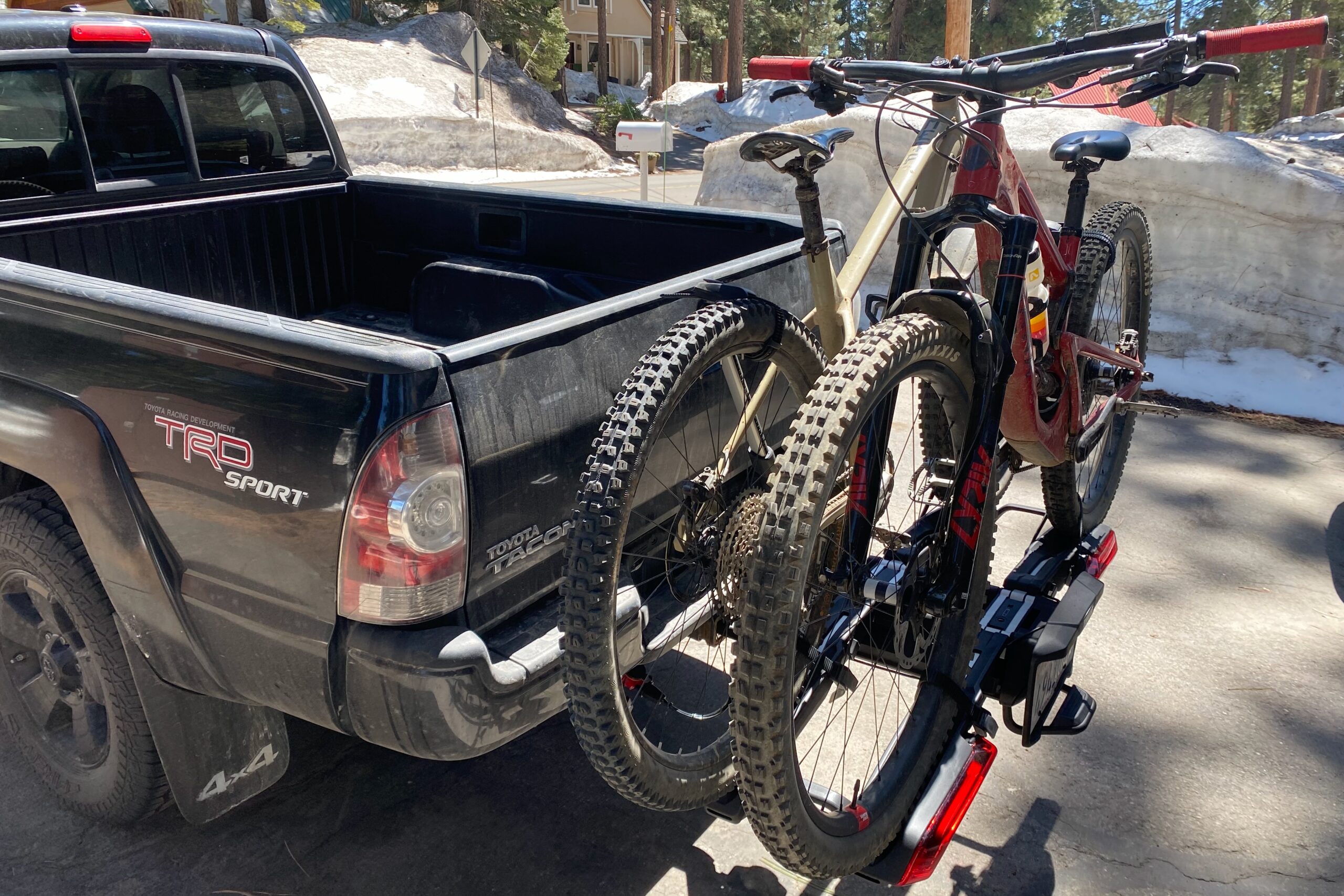
How Many Bikes Do You Need To Carry?
It may seem obvious, but the number of bikes you intend to carry when shopping for a bike rack. Many racks can be purchased in varying sizes/carrying capacities or extensions can be added on to handle more bikes.
Most tray racks come with space for two bikes, although some are offered in single or three-bike configurations. Many manufacturers offer add-ons for tray racks (depending on the model) that can expand capacity by one or two bikes. Tray rack add-ons can add significantly to the cost of your rack system.
Vertical hanging racks are typically offered in several sizes, usually between 4 and 6 bikes. While the upfront cost of vertical hanging racks is substantial, it ends up being one of the most cost-effective ways to transport 4 to 6 bikes (some brands go up to 7) other than a tailgate pad.
Top tube hanging racks are offered in various sizes ranging between 2 and 5 bikes.
How Much Do Your Bikes Weigh?
The advent of and proliferation of electric bikes has made weight capacity a common concern for those looking into a new bike rack purchase. Not all racks are created equal in this regard, so weight limits should be considered based on the bikes you intend to carry. With many e-MTBs and electric bikes weighing in the neighborhood of 50 to 60 lbs, and sometimes more, rack manufacturers have been designing racks to handle this new breed of bicycles. If you are planning to transport heavy e-bikes, it is important to get a rack that meets or exceeds the weight of your bikes for safety. The Thule Epos has the highest weight per bike capacity of all the models we tested at 75 lbs, followed closely by the Yakima StageTwo at 70 lbs. It should be noted that some racks are rated for RV and off-road use, although the weight limits typically drop down slightly in those applications.
Loading Heavy Bikes
Heavyweight electric bikes are more difficult to load, so some manufacturers have responded with rack designs and accessories to help make it easier. Lifting a 60 lb bike up and into position on a tray rack is awkward and may even be impossible for those with limited strength or mobility. Many brands now offer loading ramps that can be purchased to allow users to roll bikes up onto the trays of certain racks. A select few racks even come with this accessory included, like the Yakima OnRamp. Other racks, like the Thule Epos, Yakima StageTwo, and the Kuat Piston Pro X, are compatible with aftermarket ramps, and the racks themselves have high weight limits to handle those heavyweight rigs.

Bike Attachment Considerations
Depending on the type of bikes you have and how much you care about your frame’s finish, the way a rack secures the bike may be an important consideration. Modern carbon fiber and aluminum bikes can be very expensive, so the last thing most people want to do is damage the paint or frame material while transporting their precious rides. For this reason, top tube hanging racks should generally be avoided by those with expensive carbon bikes since they carry bikes by the frame. Limited space between bikes also makes bike-on-bike contact difficult to avoid.

Tray Racks
Most tray racks, but not all, avoid frame contact by securing the bike with either a front wheel clamp and rear wheel ladder strap, or with dual clamp arms that sandwich the bike from both ends. Front wheel clamping models such as the Thule T2 Pro XTR, Rocky Mounts MonoRail, Kuat NV 2.0, and Yakima StageTwo have hook-shaped ratcheting arms that lock the front wheel down and a strap that holds the rear wheel tight against the tray. These models avoid frame contact, but it should be noted that the front wheel hook can potentially make contact with the fork and leave abrasion marks over time, and the rear wheel strap can leave some minor scuffing on your rear rim. Dual clamp models like the 1Up-USA Heavy Duty Double, Kuat Piston Pro X, and Rocky Mounts GuideRail, hold bikes by the tires, making it easy to avoid any unwanted frame, fork, or even rim contact.
Vertical Carry Racks
Vertical carry racks vary in the way they hold bikes, with options that support bikes by the fork’s crown, front wheel, or handlebar. Models with front wheel baskets/cradles, like the VelociRAX and the 1Up Recon, make the least amount of contact with the bike as they generally only contact the front tire and have straps that hold the rear wheels in place. Racks that carry bikes by the fork crown, like the North Shore Racks and Yakima HangOver, have padded cradles that make direct contact with both the crown of your suspension fork and the bottom of the head tube and have the potential to cause abrasion marks in those areas. Vertical racks that support bikes by the handlebar are a little more versatile than the fork-carry models, but they also have the potential to cause minor abrasion damage to your handlebar’s finish.

What Kind of Bikes Do You Have?
Along with the number and weight of the bikes you need to transport is the types of bikes you have. While hitch racks are highly versatile in terms of bike fit, not all will work with every bike. Some racks are designed to work with virtually any bike out there and can support a huge range of wheel sizes, tire widths, and wheelbase lengths, while others are more limited. It is important to consider these factors when searching for the rack that best suits your needs and the bikes you’ll be transporting.
The nature of tray rack designs means they are among the most versatile in terms of bike fit. Most work with varying wheel sizes and tires ranging from skinny road bikes to mountain bike treads. Many models can fit up to 5-inch wide fatties, although some require fat bike kits. A limiting factor for some tray racks is wheelbase length, so choose wisely if you have a super long downhill or enduro bikes.
Vertical carry racks vary in their versatility depending on how they support the bike. Some models hold the bike by the crown of the fork and only work with mountain bikes with suspension forks. Models that use front wheel baskets or hang the bike by the handlebars work with a greater variety of bikes, including those with rigid forks or drop handlebars.
Top tube hanging racks are the least versatile due to the way in which they support the bikes. Adult-size frames with straight top tubes work the best. Curved tubes, small frames, or full suspension bikes may be difficult or impossible to position properly over the support arms. Most brands make adapters to carry non-compatible frames.

What Size Is Your Hitch Receiver?
When ordering a bike rack, it is critical to get one that matches the size of the receiver on your vehicle. Many vehicles, but certainly not all, come with hitch receivers installed, so be sure to double-check the size. It will be either the larger 2” or the smaller 1.25”. Can’t tell just by looking? Simply measure the width of the receiver opening to find the size. If you don’t already have one, it is possible to get one installed on most vehicles. Local auto shops or U-haul locations can typically take care of it for you. In many cases, it is also possible to do it yourself, and trailer hitch kits can typically be found online to fit your year, make, and model of vehicle.
If getting a trailer hitch installed, the 2” size is our recommendation as it is generally stronger and can support more weight. This makes it better for transporting tray racks with add-ons, racks with swing-away attachments, or vertical hanging racks. The 1.25” size also works well enough, but the weight rating is generally a little lower and some racks are only offered in the 2” size. Adapters are available to go between the two sizes, and some racks even come with adjustable receiver ends that can be switched between them.

Swing Away and Tilt Features
Most quality tray racks have a tilt function so you can fold it up when not in use, flat for transporting bikes, and tilt it down and away to access the rear of the vehicle. Some racks have convenient tilt-release handles or foot pedals and can be tilted down even with bikes on the rack. Others have less user-friendly release mechanisms that require you to reach under or around loaded bikes to tilt the rack. Most vertical and top tube hanging racks also have tilt features for easier access to the rear of the vehicle.
People who have camper vans, cabover campers, or simply want wide open access to the back of the vehicle should consider racks that swing away or adding a swing away/pivoting attachment to the rack of your choice. This allows the entire rack to pivot out and to the side, making it easier to open large doors or simply enjoy unrestricted access to your trunk (boot), truck bed, or camper. A select few racks come with this feature built into the design, like the Rocky Mounts Backstage, but most major manufacturers also make swing-away attachments. These attachments are typically only available in the 2” receiver size for racks that also have 2” receiver ends, and they add significantly to the weight and cost of your rack system.

Vehicle Clearance
The clearance between the rack, bikes, and your vehicle is worthy of consideration. Nobody wants to have their rear window broken by their handlebar while in transit or need to loosen and turn their handlebar every time they load a bike on the inside tray. Some trailer hitches are mounted further underneath the vehicle, making the rack itself sit closer to the rear bumper. Additional factors like the style of vehicle and the design of the bumper and rear door also play a role. Some racks play nice with just about any vehicle while others can have a tighter fit that can cause contact between handlebars and rear windows or doors. This is most common with tray racks and vehicles with vertical rear doors like campervans that can be more problematic in this regard compared to those with sloping rear ends like station wagons and hatchbacks.
Most rack manufacturers provide technical specs or fit guides on their websites for reference. This link to Kuat’s Piston Pro X Fit Guide is a good example that gives you all the measurements you need for that specific rack. Comparing your measurements to the rack’s specs should give you an idea of whether or not a rack will fit. Still, that doesn’t always solve the handlebar clearance issue, although that is generally most prevalent with vertical rear doors. In some cases, it may be necessary to get a hitch extension to achieve the proper clearance for your vehicle. Fortunately, most brands offer hitch extensions as an aftermarket accessory, some of which also raise and lower the height of the rack. Vertical hanging racks usually have fewer clearance issues as they typically have an angle adjustment to position it properly to avoid any interference with the rear of the vehicle.

Security
Bikes can be very expensive, so keeping them safe is a priority for most users. The last thing anyone wants is to stop for a quick errand and find their bike(s) stolen when they return. Many racks, but not all, come with included security features like cable locks integrated or semi-integrated into their design. While these features are undoubtedly much better than nothing, they are typically little more than a theft deterrent. We always recommend adding a beefy aftermarket lock to your rack for an added layer of security and peace of mind. You can learn more in our review of the best bike locks.
Racks are also fairly expensive, so keeping them safe and secure is also very important. Fortunately, most hitch racks come with hitch pin locks or locking knobs to secure them to the vehicle. Some require the use of special security allen keys to tighten or loosen them on the hitch. Hitch pin locks are fairly inexpensive, and a great addition to any rack that doesn’t already come with one.

Assembly
When you purchase a hitch bike rack from a brick-and-mortar retailer, they will typically assemble the rack for you and potentially even help you install it on your vehicle. When you purchase a rack online, it usually arrives at your home in a large box with some assembly required to prepare it for use. The assembly process varies between models and some are more involved than others, but generally, it isn’t too difficult. Most models come with detailed instructions and the tools needed to complete the steps in the process. Often you can find an instructional assembly video (or scan a QR code) if you prefer to see it done. We recommend following the instructions exactly for the easiest and most streamlined assembly.

Storage
While many people will choose to leave their hitch rack on their vehicles at all times, most people will take it off seasonally or when they aren’t planning to use it for an extended period. You’ll need somewhere to keep it, and most hitch racks are fairly bulky and take up a fair amount of space in your garage, shed, or storage location. This is especially true of most vertical hanging and tray models, although a few collapse to a smaller size to make storing them more convenient. Some companies make wall-mountable hitch docks that can hold your rack up off the ground to keep things tidier. Top tube hanging racks tend to be the easiest to store given their narrower collapsed dimensions.

Value
There’s no denying that hitch bike racks are expensive. Prices have been steadily increasing and the highest-end models now top $1,000. Unless you’re rolling in disposable income, that’s a tough pill to swallow for most people. Sure, more expensive racks typically have fancy features and high-end finishes, but most people don’t need to spend that much to get a rack that gets the job done.
Realistically, the least expensive models we tested work nearly as well as the high-priced options. All of them work better than no rack at all. Of course, the price of some racks goes way up when you need to add capacity. Tray racks get much more expensive when you factor add-ons into the equation. Those needing to carry many bikes at once would be wise to check out the vertical hanging options. While the upfront cost is fairly high, they cost less than some racks with add-ons for carrying 4 or more bikes at a time.
Frequently Asked Questions About Hitch Bike Racks
There are a number of reasons to choose a hitch rack over a trunk or roof rack. First, other than touching the hitch receiver, the rack itself doesn’t make contact with your vehicle (unless used incorrectly). Trunk racks can cause damage to your vehicle’s paint while roof racks need to be attached to your factory roof bars or require aftermarket bars attached to the vehicle.
Hitch racks also have a low loading height and simpler loading process that makes them more user-friendly. For tray racks, you only need to lift the bike wheels as high as the tray. Roof racks require you to lift your bike to the height of the roof and loading them can be awkward. Trunk racks require you to lift the bikes to the height of the support arms.
Hitch racks are versatile in terms of bike fit, and most can handle a wide variety of wheel sizes, tire widths, frame shapes, and wheelbase lengths. Hitch racks are better for your bikes as they typically keep them from contacting one another or your vehicle when in transit. You also won’t run the risk of accidentally driving into the garage with your bike on the roof of your vehicle and potentially damaging your bike, vehicle, and home all at the same time.
It really depends on your needs. The best rack will be the one that carries the number and type of bikes that you have, fits your vehicle, and fits your budget. Doing lots of mountain bike shuttles or need to transport more than 4 bikes? Look into the vertical carry models. Only carrying one or two bikes at a time? The tray racks are your best bet. Need to haul heavy e-bikes? Check out the racks with a high weight capacity and compatibility with a loading ramp (and get the loading ramp). If you’re short on storage space, pick one that folds down small or isn’t too heavy. There are enough options that you should be able to find one that suits your needs.
Because of all that testing, plus premium materials, legitimate engineering and design, and more. Here’s the deal: We’ve tested some pre-production racks before and found issues, so these name-brand brands push back the release date and fix the problems. If brands that are experienced in making hitch racks don’t always get it right on the first try, would you trust that no-name online-only brands will? We wouldn’t.
Do you want your bikes to arrive safely at the same destination as you? If yes, then know that all of the brands listed here extensively test their racks for strength, durability, and longevity. They test the coatings and hardware against road salt and other corrosive elements. They go through rigorous tests in the lab and out in the wild. We’ve toured some of their headquarters and seen the testing firsthand. It’s unlikely you’ll put these racks through the same torture, but it’s good to know they can take it.
Of course, you can leave your hitch rack on your car all the time but it depends where you live and how much you use it. Some of us leave our racks on the car year-round without issue. These racks see a lot of rain, cross-country road trips, and bake in the sun, and they’re fine. That said, if you live somewhere it snows a lot in the winter or you’re not using it for months at a time, it’s probably better to take it off and keep it clean and dry rather than subject it to unnecessary abuse.
Most of these racks use an aluminum frame, but the hardware and hitch beam are usually steel. So, use your judgment. If everything else metal is rusting around you from salt air or road spray, you should probably hose it off and store it somewhere dry when not in use.
If you don’t already have a trailer hitch on your car, we recommend going with a 2″ size if possible. Some smaller cars will only find 1-1/4″ hitches available because manufacturers assume you won’t be towing bigger, heavier loads, so they don’t offer 2″ hitches for many compact cars.
If you plan on adding any extensions to your rack and carrying more than two bikes, you’ll need a 2″ hitch to handle that weight. You’ll also need a 2″ hitch if you plan on adding a swing-away adapter or anything else that extends or expands your carrying capacity.
In North America, U-Haul is one of the main places that people go to get a trailer hitch installed. They can do the wiring harness too if you need it. Otherwise, you can probably find a local mechanic who will happily install one for you. If you’re the DIY type, kits are available online for nearly every make and model of vehicle that you can install yourself.
Related Content

The Best Bike Locks of 2024
If you own a bike of any sort, you should own a bike lock. Bike theft is a common occurrence and looking closely will show…

